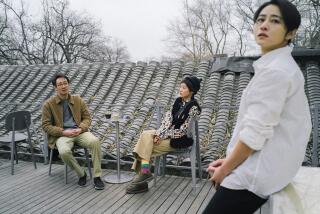Fu Manchu hasn’t cursed ‘Hollywood Chinese’ exhibit
Growing up in San Francisco’s Chinatown, Arthur Dong loved going to the movies and began collecting movie fliers when only 7. The first one, like first love, is imprinted in memory — “Flower Drum Song” (1961), based on a hit Rodgers and Hammerstein musical about the Chinese American generation gap. “It was really something because it was the first English-language film shown at the Great Star Theatre,” he recalls, “and also because it was a Hollywood film with all Asian actors.”
Little did he know then that this little sheet of paper, mostly in Chinese and illustrated with photos of actress Nancy Kwan leading a crew of hoofers down Grant Avenue, would become the centerpiece of his collection of Hollywood ephemera on Chinese actors and filmmakers. Today it hangs on a wall in the exhibition “Hollywood Chinese: The Arthur Dong Collection” (till Nov. 7) at the Chinese American Museum in El Pueblo de Los Angeles Historical Monument downtown.
The exhibition provides a lively tour through a century of stereotypes and breakthroughs. It features vintage posters, lobby cards, photographs, documents, memorabilia and even the Oscar statuette won by James Wong Howe for his cinematography on “The Rose Tattoo.” Dong, a documentary filmmaker, doesn’t see himself as a collector. “I put these things together as part of my research” during the decade he worked on his film “Hollywood Chinese” (2007), on the same topic, he says.
The opening section is about the idea of Chinatown and how films from early on demonized the location — and its inhabitants — as dark and dangerous. There are posters from “Captured in Chinatown” (1935) to “Year of the Dragon” (1985). The trend reached a pulpy nadir in Fu Manchu, an archvillain invented by British novelist Sax Rohmer and made into a series of movies in the late 1920s and early 1930s. One photo shows Boris Karloff being prepped with heavy eye makeup and wickedly long mustache for the title role in “The Mask of Fu Manchu” (1932). Yellowface, where Caucasian actors played Asian roles, was common up through “The Good Earth” (1937), which has its own section, and beyond.
“The beginning years it was all about exoticism,” Dong says. “Which if you look at today’s product, it’s still there. I want to show different aspects of that construction and to deconstruct that too, I guess. To show there was progress, but there’s regression as well.”
Sixties superstar Nancy Kwan has her own section — Kwan starred in two major Hollywood films back to back, “The World of Suzie Wong” and “Flower Drum Song.” The first, in which she played a kittenish dance hall girl in the honky-tonk Wanchai district of British Hong Kong, put her on the cover of Life magazine. It was a landmark for an Asian to play a key role in a mainstream feature, let alone an Asian part.
At the time, says Kwan via a telephone interview, she wasn’t aware of making history. “Bill Holden [her costar] was a major star. I just felt so lucky playing opposite him,” she says. However, she points out, “that film opened a lot of doors for Asian actors, awareness that Asians can do these type of roles.” With “Flower Drum Song,” she was aware of participating in something momentous. With the influx of talent from Hong Kong and China recently, she adds, “there’s more awareness, but I still think we’re far from catching up, compared to African Americans or Latin Americans.”
More to Read
The biggest entertainment stories
Get our big stories about Hollywood, film, television, music, arts, culture and more right in your inbox as soon as they publish.
You may occasionally receive promotional content from the Los Angeles Times.






